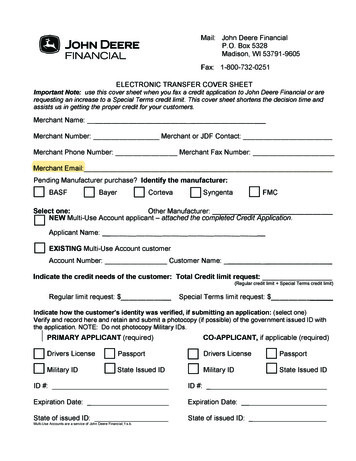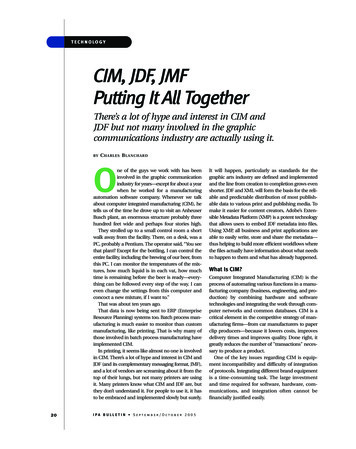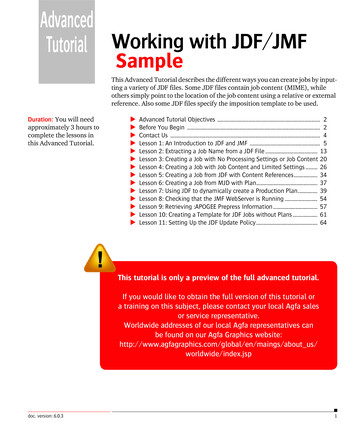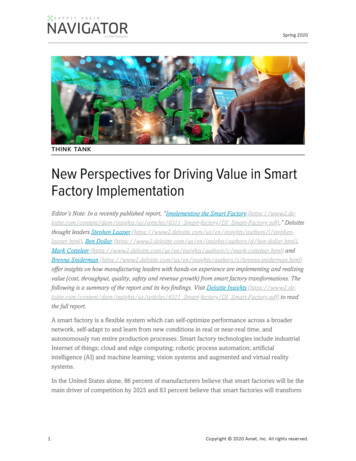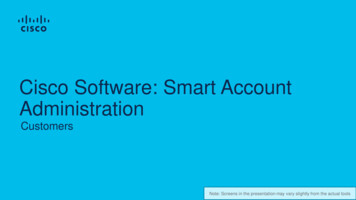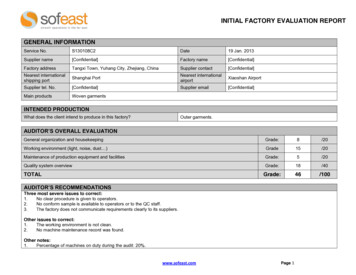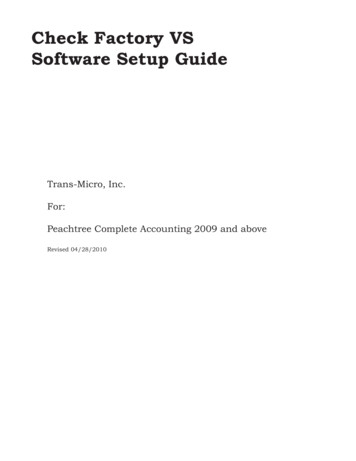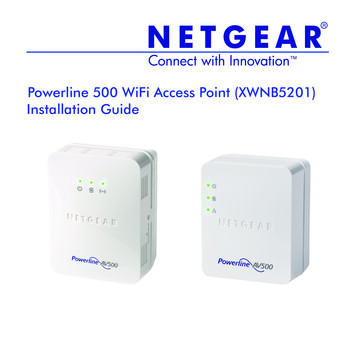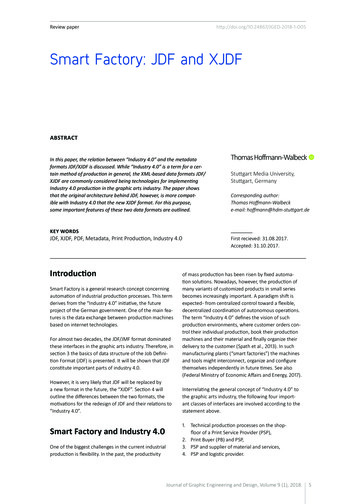
Transcription
Review paperhttp://doi.org/10.24867/JGED-2018-1-005Smart Factory: JDF and XJDFAbstractIn this paper, the relation between “Industry 4.0” and the metadataformats JDF/XJDF is discussed. While “Industry 4.0” is a term for a certain method of production in general, the XML-based data formats JDF/XJDF are commonly considered being technologies for implementingIndustry 4.0 production in the graphic arts industry. The paper showsthat the original architecture behind JDF, however, is more compatible with Industry 4.0 that the new XJDF format. For this purpose,some important features of these two data formats are outlined.Thomas Hoffmann-WalbeckStuttgart Media University,Stuttgart, GermanyCorresponding author:Thomas Hoffmann-Walbecke-mail: hoffmann@hdm-stuttgart.deKey wordsJDF, XJDF, PDF, Metadata, Print Production, Industry 4.0IntroductionSmart Factory is a general research concept concerningautomation of industrial production processes. This termderives from the “Industry 4.0” initiative, the futureproject of the German government. One of the main features is the data exchange between production machinesbased on internet technologies.For almost two decades, the JDF/JMF format dominatedthese interfaces in the graphic arts industry. Therefore, insection 3 the basics of data structure of the Job Definition Format (JDF) is presented. It will be shown that JDFconstitute important parts of industry 4.0.However, it is very likely that JDF will be replaced bya new format in the future, the “XJDF”. Section 4 willoutline the differences between the two formats, themotivations for the redesign of JDF and their relations to“Industry 4.0”.Smart Factory and Industry 4.0One of the biggest challenges in the current industrialproduction is flexibility. In the past, the productivityFirst recieved: 31.08.2017.Accepted: 31.10.2017.of mass production has been risen by fixed automation solutions. Nowadays, however, the production ofmany variants of customized products in small seriesbecomes increasingly important. A paradigm shift isexpected - from centralized control toward a flexible,decentralized coordination of autonomous operations.The term “Industry 4.0” defines the vision of suchproduction environments, where customer orders control their individual production, book their productionmachines and their material and finally organize theirdelivery to the customer (Spath et al., 2013). In suchmanufacturing plants (“smart factories”) the machinesand tools might interconnect, organize and configurethemselves independently in future times. See also(Federal Ministry of Economic Affairs and Energy, 2017).Interrelating the general concept of “Industry 4.0” tothe graphic arts industry, the following four important classes of interfaces are involved according to thestatement above.1. Technical production processes on the shopfloor of a Print Service Provider (PSP),2. Print Buyer (PB) and PSP,3. PSP and supplier of material and services,4. PSP and logistic provider.Journal of Graphic Engineering and Design, Volume 9 (1), 2018.5
There are, in fact, some more areas, that are also considered being part of Print 4.0. In practice, they dependon each other, which is graphically illustrated in figure1. The pyramid shows a certain hierarchy. In this paper,only the vital interfaces in the production processes atthe PSP are discussed. The other areas of automationare outlined e.g. in (Hoffmann-Walbeck & Riegel, 2017).This metamorphosis of production methods might becutting-edge technology for the industry in general, forthe graphic arts industry, however, it is not. For mostPSPs diversity of variants and short run-lengths are dailyroutines. Different technologies of metadata like XMP(ISO, 2012), Web services, CSV are used for this matter,but JDF/JMF still is the most elaborate and dominantcommunication model.»»Figure 1: Sub-topics of Industry 4.0 inGraphic Arts IndustryJob Definition Format (JDF)The first specification of the Job Definition Format(JDF) (CIP4, 2013) had been published in 2001 andcomplies with the concept of the smart factory in theprinting industry (“Printing 4.0”). To show that, let usrecap some of the important structures of the format (See also (Hoffmann-Walbeck & Riegel, 2012).With JDF, one can describe the intended product itself,as well as the processes that are needed to produce the»»Figure 2: JDF nodes6product and its product parts. Processes can be encapsulated into “Process Groups”. All product (parts), process groups and processes are described by XML nodeswith the tag-name “JDF”, which are actually called “JDFnodes”. The JDF nodes are structured as a tree, whereasthe root typically represents the product itself and thechildren the product parts and/or processes and processgroup nodes. The process nodes and/or process groupnodes that are descendants of a product node describethe processes concerning the production of the product or product part. Figure 2 shows a fictive and simpleexample. Here, the Product Nodes are highlighted inred, the Process Groups in gray and Process Nodes inyellow. The tree does not reflect any process order.Typically, a Management Information System (MIS) - i.e. asoftware for managing customer orders - initiates writingJDF data and generates the product node and productpart nodes for a job order. It can also define processesand process groups, but since the MIS would not knowmuch about the technical details of the required production processes, it can do that only in a superficialmanner. During the production, other devices will addthe necessary details as well as the results of the process execution (status, used resources and the like).That is, the JDF data enlarges during production. In theend, the JDF will contain all settings of the productionworkflow, provided by all components that are JDF savvy.Normally, such a JDF file contains dozens of JDF nodes.The JDF workflow representation is based on the “process-resource-model” (PRM). A process is an activity,while resources are either physical entities (paper, plates,ink ) or electronic data (PDF files, images, profiles,parameter sets ). These resources are either inputor output resources for a JDF node. An input resourceof a process node is an entity that is needed for theexecution of the process; an output resource is the outcome of the process. An input resource for a productnode is called a “Intent Resource”, because it describesthe customer’s intention of the printed product. Figure 3 represents a small segment of a fictive PRM.
»»Figure 3: Process-Resource-ModelThe PRM is merged into the node tree. Each node contains a reference to its input and output resources. Manyresources are referenced by two or more JDF nodes. Anoutput resource of a process node, for example, may bean input resource for another process (like Resource 4,Resource 5 and Resource 7 in figure 3). The main ideaof automation using JDF metadata is that devices canexecute processes automatically, if all input resources areavailable, the device is idle and the production window(time span) is met. However, since it is not advisableto have different copies of a resource in the JDF data,a resource can be “almost anywhere” in the JDF dataand is not necessarily placed inside a JDF node thatrefers to the resource. Inside a JDF node, however, thereferences of this node must be specified via an unambiguous identifier. This leads to a highly structured netof nodes, resources and references between the two.One way to communicate JDF data is that it can besent (as a file) from device to device. Each device thenextracts the information from the file (typically one ormore JDF nodes and all resources that are referenced)and adds new entries into the file (e.g. operational data).This linear fashion of passing JDF data around can beenhanced by parallel distribution, since JDF allows locking parts of the data, so that two different devices neednot extend JDF data concerning the same data part.This architecture is getting close to the ideas ofindustry 4.0, which has been postulated morethan a decade after the specification of JDF. Evenplug-and-play features are part of the JDF specification (though still far away from implementation)as well as descriptions of device capabilities.Sending entire JDF files from device to device, however,is not common (any more). Most devices are, in fact,controlled by one or several JDF controllers. These controllers pass along individual and appropriate JDF datato each device they control and integrate the updateddata which they receive from the devices. This actuallyrelieves the devices from the burden of understandingand managing the entire workflow and the controllermight have other means (like private databases) todetermine the production workflow. This architecture,however, moves away from the vision of Industry 4.0.All devices, however, still must be prepared to receive afull JDF workflow description and must be able to extractall relevant information out of it by its own means.XJDFXJDF is a redesign of JDF that is currently specified(CIP4, 2017). See also (Meissner, 2017). JDF is a verypowerful, but in the same time quite a complex language as explained. There are node hierarchies to beobserved, there are resources to be searched for inthe data and there is a merger of product and processdescriptions. Furthermore, JDF even is not even pureXML, e.g. properties of so-called “Partitioned Resources” can be inherited. Thus JDF is hard to interpret,expensive to implement and prone to incompatibilities. Because of this complexity, change orders andganging jobs are not so easy to implement in JDF.In particular, since a controller usually defines the production workflow internally in private databases anyway, there is no need to describe the entire productionworkflow in XML as well. Also, JDF based productionenvironments tend to become slow, when a hugeamount of jobs are processed simultaneously, sincereading and analyzing XML text files are less efficientthan, for example, querying a database. With XJDF, anoverall workflow description has been abandoned altogether. XJDF will become mainly an interface languagebetween a controller and a device. In order to state thisfact more generally: XJDF is a communication protocolbetween two applications. This makes things a lot easier,especially for the devices. Any device receives typically only a single process node now, which contains allresources it needs for executing the process. Referencesto resources outside the process node are not requiredany longer. Change orders should be easier to handle,since now it is only necessary to send new versions ofXJDF data to those devices that needs to know aboutit. The XJDF structure is very flat (compared to the JDFstructure). A XJDF node for a specific process typicallycontains a product list and resource sets (See figure 4).Journal of Graphic Engineering and Design, Volume 9 (1), 2018.7
»»Figure 4: Snippet of XJDF Sample Code of process “Folding”The product list contains one or several products orproduct parts from the PB’s point of view. The properties of the intent products are defined by intent-elements. The resource sets describe resources that arerequired by the process. In addition, XJDF is pure XML,so that standard XML tools can be used for handling.Figure 5 shows a simplified architecture of an XJDFconfiguration. The Workflow Controller keeps a job listin a database and for each job a set of parameters arestored for each process (device). In figure 5 only twoprocesses are listed. The controller specifies whichprocesses are needed for a given job as well as thedata that are required for each process. This information typically will stem from some job ticket that thecontroller imported, by default values or by the entriesthat an operator has filled in a graphical user interface.The manufacturer of the controller is free to design thedatabase (or any other means of storage) accordingto his own wishes. The data in the database could bespecified like the resource elements in the XJDF, butthey do not have to be compatible with XJDF at all. Thecontroller only has to convert its own data into a XJDFresource list for the XJDF device. To illustrate this fact,we modified the color of the data in the DB and in XJDF.With XJDF, there is no more fixed connection between asingle product description and the definition of production processes like it was with JDF. The above-mentionedproduct list in XJDF can contain descriptions of severalindependent products. This will make the implementation of ganging jobs easier. Furthermore, it reflects thesituation of Web-to-Print configurations much better.Moreover, in future times, one might store productdescription outside of XJDF altogether. The product description might be stored within a Page Description language. In (CIP4, 2015) a set of PDL-independent standardmetadata keywords are defined, which enables productdescription. In PDF, this metadata can be stored by theDPART-element of PDF/VT (ISO, 2010) respectively PDF2.0 (ISO, 2017). XJDF might then only contain productionresources.»»Figure 5: Configuration of Controller and Devices applying XJDF8
ConclusionsThe JDF specification has anticipated the vision of“Industry 4.0” in parts. The current implementationsof JDF-based workflow software, which predominantlycan be found in offset and in digital printing, movedaway from the original idea of decentralization. Thiswill be even more so for XJDF. Since XJDF, however, ismuch easier to implement in a production workflowthat JDF, the format XJDF might become an importantindustry standard or might even replace JDF altogether in the future nevertheless. It will be interesting toobserve, if the vision of “Industry 4.0” will also recollectthe concept of centralization in the years to come.The shift of production description from JDF/XJDF towards PDF, however, supports the interface between PB and PSP according to the missionstatements of Printing 4.0. This concept, however, has not yet been implemented so far.The other data formats XMP and CSV mentionedin this paper are container formats, which usually only transport private data between differentsoftware modules of a single manufacturer. Thereare no standard descriptions for production processes or resources concerning those formats.ReferencesInternational Organization for Standardization (2010)ISO 16612-2:2010. Graphic technology - Variable data exchange - Part 2: Using PDF/X-4 andPDF/X-5 (PDF/VT-1 and PDF/VT-2). Geneva, ISO.International Organization for Standardization (2012)ISO 16684-1:2012. Graphic technology - Extensiblemetadata platform (XMP) specification – Part1: Datamodel, serialization and core properties. Geneva, ISO.International Organization for Standardization (2017) ISO32000-2:2017. Document Management - PortableDocument Format - Part 2: PDF 2.0. Geneva, ISO.Federal Ministry of Economic Affairs and Energy, FederalMinistry of Education and Research. (2017) PlattformIndustrie 4.0. Available from: http://www.plattform-i40.de/I40/Navigation/EN/ [Accessed 1st May2017].Hoffmann-Walbeck, T. & Riegel, S. (2017) Advances inDigital Production Workflows. In: Media TechnologyDepartment of the Technology Faculty at Kaunokolegija/University of Applied Sciences. InternationalScientific-Practical Conference Innovations in Publishing, Printing and Multimedia Technologies 2017.Kaunas, Kauno Kolegija/University of Applied Sciences. pp. 30-34. Available from: ferencija 2017.pdfHoffmann-Walbeck T. & Riegel, S. (2012) JDF Workflow: AGuide to Automation in the Graphic CommunicationsIndustry. Warrendale, Printing Industries of America.Meissner, S. (2017) XJDF – Exchange Job Definition Format. Regensburg, Ricebean.net.Spath, D. [ed.], Ganschar, O., Gerlach, S., Hämmerle,M., Krause, T. & Schlund, S. (2013) Produktionsarbeit der Zukunft – Industrie 4.0. Fraunhofer-Institut für Arbeitswirtschaft und Organisation IAO.Stuttgart, Fraunhofer Verlag. Available roduktionsarbeit/de/documents/FraunhoferIAO-Studie Produktionsarbeit der Zukunft-Industrie 4 0.pdf [Accessed 1st May 2017].The International Cooperation for the Integration ofProcesses in Prepress, Press, and Postpress Organization -CIP4 (2013) JDF-Specification, release1.5. Available from: https://confluence.cip4.org/display/PUB/JDF [Accessed 1st May 2017].The International Cooperation for the Integration ofProcesses in Prepress, Press, and Postpress Organization CIP4 (2017) XJDF Specification, 2.0-RC-143. Available from: https://confluence.cip4.org/display/PUB/XJDF [Accessed 29th October 2017].The International Cooperation for the Integration ofProcesses in Prepress, Press, and Postpress Organization -CIP4 (2015) ICS — Common Metadatafor Document Production Workflows. Availablefrom: https://confluence.cip4.org/display/PUB/Common Metadata for Document Production Workflow ICS [Accessed 29th October 2017]. 2018 Authors. Published by the University of Novi Sad, Faculty of Technical Sciences, Department of Graphic Engineering and Design. This article is an open access article distributed under the terms and conditions of the CreativeCommons Attribution license 3.0 Serbia ournal of Graphic Engineering and Design, Volume 9 (1), 2018.9
(ISO, 2012), Web services, CSV are used for this matter, but JDF/JMF still is the most elaborate and dominant communication model. » Figure 1: Sub-topics of Industry 4.0 in Graphic Arts Industry Job Definition Format (JDF) The first specification of the Job Definition Format (JDF) (CIP4, 2013) had been published in 2001 and
